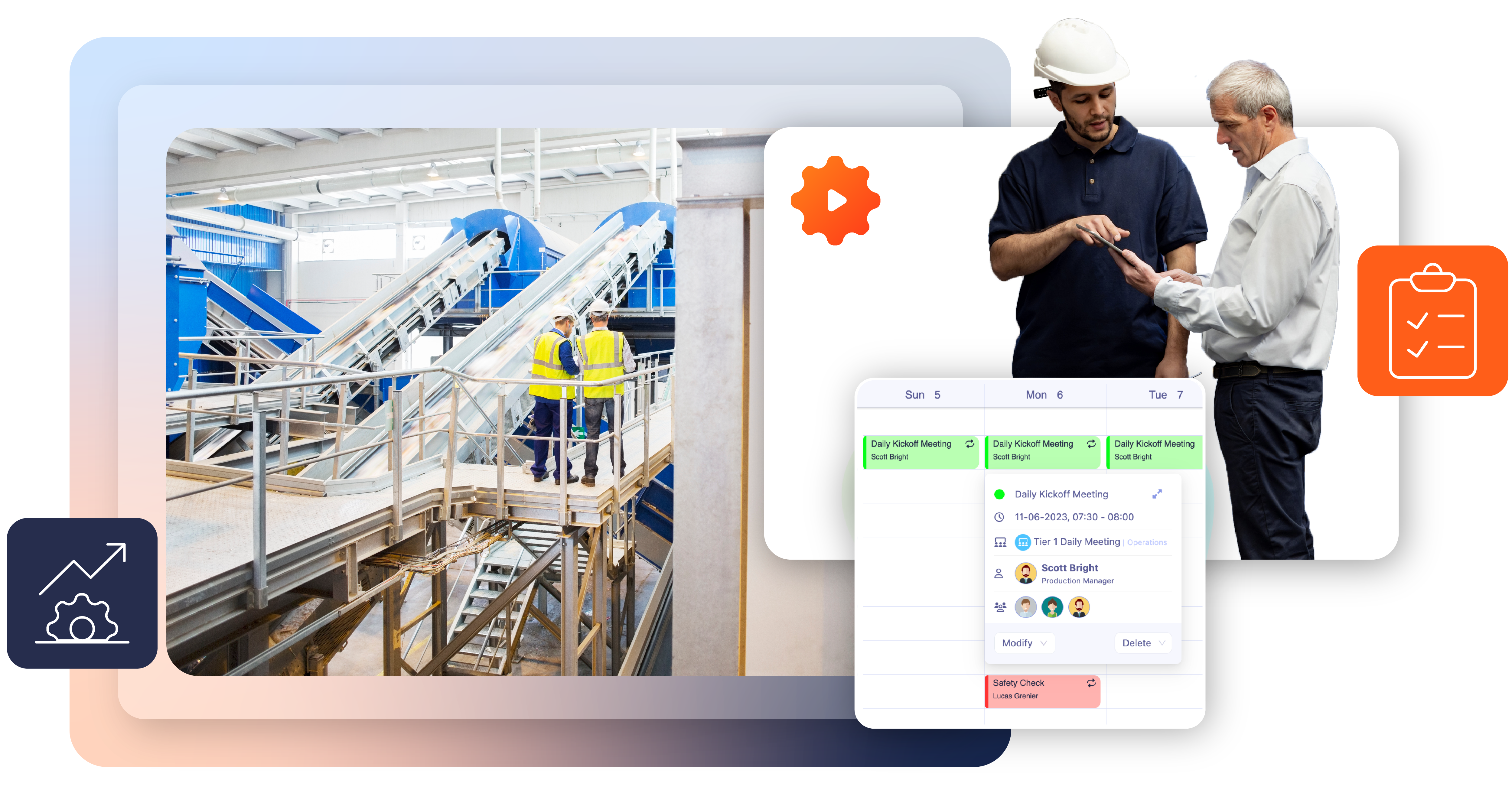Benefits of Leader Standard Work and Lean Leadership Routines

| Last updated: | September 5, 2025 |
- Drives accountability and visibility: Clearly defines roles, reinforces responsibility, and improves transparency in daily operations.
- Boosts safety and compliance: Embeds preventive checks, safety inspections, and regulatory audits into management routines.
- Strengthens leadership and improvement culture: Standardizes managerial practices, fosters communication, and accelerates onboarding while engaging all levels in continuous improvement.
Do your supervisors and managers need to be more accountable regarding your performance objectives? Do they have regular management routines (process audits, 5S audits, safety inspections, Gemba Walks, meetings)? Without Leader Standard Work and Lean Leadership Routines, you’re likely seeing skills gaps between your different team leaders.
Address this challenge by implementing Leader Standard Work. LSW involves planning and standardizing routines, activities, behaviors, and management tools in the agenda of supervisors and team leaders. The following article examines its nine main benefits.
The 9 Benefits of Leader Standard Work and Lean Leadership Routines
1. Promoting Accountability
First off, introducing Leader Standard Work promotes managerial accountability by clearly defining roles and functions. LSW fosters a culture of accountability. For example, the agenda specifies that every Monday morning, managers must lead a team meeting to discuss the week’s objectives. Every day, they must devote an hour to priority management, and every month, they must present a progress report to the management committee. This approach clarifies roles and reinforces accountability because managers know what is expected of them at each stage.
2. Improving Operational Control and Proactive Supervision
Planning and standardizing management routines helps managers maintain control over day-to-day operations. Indeed, operating in anticipation mode limits the time and costs associated with problems. One of the main benefits of LSW is the shift from firefighter mode to an operational level of control by including preventive control periods in the manager’s schedule. For example, Gemba Walks allow supervisors to walk around the facility to engage with their teams and proactively identify problems, improvement opportunities, and potential solutions.

10 Steps to Implement Leader Standard Work in 4 Weeks
3. Increasing Performance Visibility
Furthermore, Daily Standard Work increases transparency in management processes. Implementing such a program gives management greater visibility over various aspects. From the problems identified and documented to the health of management processes via follow-up of corrective actions, right through to the tasks assigned to support teams, everything is easily visible.
4. Standardizing Managerial Performance and Developing Leadership Skills
Leadership Routines standardize managerial habits and skills throughout the company and between managers. Routines contribute to management standardization, bridging the gap between managers’ leadership skills and ongoing training. As a result, managers are better equipped to carry out their duties and continually develop good management reflexes.

5. Enhancing Workplace Safety
In addition, implementing Leader Standard Work reinforces preventive action and verification of safety standards in day-to-day tasks. For example, team leaders can carry out daily safety inspections, and managers can carry out weekly HSE audits. Carrying out safety checks as part of Leader Standard Work reinforces safety prevention in the workplace and reduces risks.
6. Ensuring Compliance with Regulatory Standards and Practices
Organizations generally have regulatory practices to adhere to regarding quality, safety, and the environment, in addition to ISO standards or internal procedures.
To comply with these requirements, Lean Leadership Routines are essential in scheduling audits and inspections. Managers plan them and ensure that regular or periodic audits and inspections are carried out systematically.
7. Facilitating Communication
Moreover, Leader Standard Work encourages regular communication, both top-down and bottom-up, between team members, limiting misunderstandings and ensuring that everyone is on the same page. It’s also easier to schedule daily, weekly, monthly, and quarterly meetings when everyone has the same standard agenda.
8. Involving All Organizational Levels in Continuous Improvement
Consider a plant producing electronic components and implementing LSW. Every day, at start-of-day meetings, managers discuss the problems they are encountering, from production faults to unplanned downtime. Teams work together to find solutions, whether by adjusting machine parameters or improving processes. By involving all staff in identifying and resolving problems in their daily tasks, Leader Standard Work fosters a culture of continuous improvement.
9. Standardize and Accelerate New Manager Onboarding
Finally, it can be complicated to train new managers when there are no standards in place. Routines guide new managers in their day-to-day roles. From their very first day, they will adopt good management reflexes for leading meetings, carrying out audits, Gemba Walks, and so on. Management routines can naturally include the following:
- A standardized onboarding process.
- Well-defined expectations.
- Regular performance monitoring to ensure a smooth transition from technical to management roles.
Tervene's Lean Leadership Routines and Daily Standard Work Solution
In sum, Leader Standard Work and Lean Leadership Routines promote accountability, improve operational control, increase visibility, standardize performance, enhance workplace safety, ensure compliance, facilitate communication, encourage continuous improvement, and simplify onboarding.
Tervene is an all-in-one solution for successfully implementing a successful Leader Standard Work program (LSW) within organizations. Just a click away, access all the tools and support you need to optimize your operations, gain visibility, and support continuous improvement.




























